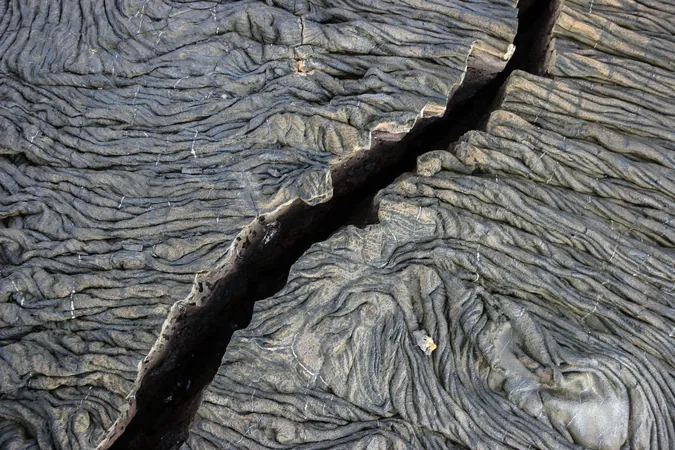
Unlocking Earth's Secrets: How Ancient Tectonic History Shapes Our Planet's Future
2025-04-10
Author: Arjun
Ancient Anomalies: The Key to Understanding Subduction
In a groundbreaking revelation, new research has uncovered a crucial connection between the ancient tectonic history of oceanic plates and their journey into the Earth's mantle. Compositional anomalies, molded over millions of years, are now recognized as key players in determining how these plates descend and their ultimate fate.
The Dance of Plate Tectonics
Plate tectonics—the slow but powerful ballet of Earth's lithospheric plates—serves as the foundation for our planet's stability. A critical aspect of this drama is subduction, where one plate slides under another, initiating the recycling of surface materials and volatile elements deep within the Earth. This ongoing process is essential for preserving climate stability and the atmospheric balance that sustains life over geological epochs.
A Surprising Breakthrough in Earth Science
An international team of seismologists, led by the University of Southampton (now affiliated with the Woods Hole Oceanographic Institution), has revealed a previously unknown factor influencing this vital process: the ancient tectonic history imprinted within the subducting plates. Their study, published in the prestigious journal *Nature*, focuses on the mantle transition zone (MTZ), a pivotal layer located between 410 and 660 kilometers deep, regulating the flow of materials to the deeper mantle.
Echoes from the Past: The MTZ's Role
The researchers discovered that substantial accumulations of basalt rock in the MTZ can significantly slow down subducting plates or even trap them temporarily, hindering their descent into the lower mantle. Previous studies acknowledged basalt reservoirs in the MTZ, but their origins were elusive. This research provides compelling evidence of an unusually thick MTZ beneath the Lesser Antilles, potentially consisting of basaltic material spanning the entire 100-kilometer thickness of the oceanic slab in specific regions.
The VoiLA Project: A Seismic Marvel
This astonishing discovery stemmed from the VoiLA (Volatiles in the Lesser Antilles) project, an extensive ocean bottom seismic experiment involving 34 advanced seismometers deployed on the ocean floor beneath the Lesser Antilles arc. Dr. Catherine Rychert, part of the Woods Hole Oceanographic Institution, noted, "This is the first large-scale ocean bottom seismic experiment conducted at an Atlantic subduction zone," emphasizing its pioneering nature.
A Tectonic Memory with Lasting Effects
In addition to its immediate findings, the study offers profound implications. Dr. Nick Harmon, formerly from the University of Southampton and now with Woods Hole, stated, "It’s wild to think that in some ways tectonic plates have a ‘memory’ that affects how they drive mantle convection and mix material back into the Earth." This ‘memory’ reflects the compositional variations inherited from ancient tectonic actions, ultimately shaping the fate of these sinking giants.
A Call to Action for Future Research
Dr. Xusong Yang, the study's lead author and now at the University of Miami, underscored the necessity of recognizing these inherited heterogeneities, asserting, "We cannot overlook the past’s influence on subducting oceanic slabs. It may profoundly impact their ultimate fate in the depths of our planet."
Connecting the Past to the Planet's Future
Ultimately, this research highlights how Earth's history is intricately woven into its future. The tectonic events shaping oceanic plates continue to influence the planet's inner workings, with significant implications for its geological and climatic future. While these changes unfold slowly, they carry immense significance when viewed against the backdrop of geological time.





 Brasil (PT)
Brasil (PT)
 Canada (EN)
Canada (EN)
 Chile (ES)
Chile (ES)
 Česko (CS)
Česko (CS)
 대한민국 (KO)
대한민국 (KO)
 España (ES)
España (ES)
 France (FR)
France (FR)
 Hong Kong (EN)
Hong Kong (EN)
 Italia (IT)
Italia (IT)
 日本 (JA)
日本 (JA)
 Magyarország (HU)
Magyarország (HU)
 Norge (NO)
Norge (NO)
 Polska (PL)
Polska (PL)
 Schweiz (DE)
Schweiz (DE)
 Singapore (EN)
Singapore (EN)
 Sverige (SV)
Sverige (SV)
 Suomi (FI)
Suomi (FI)
 Türkiye (TR)
Türkiye (TR)
 الإمارات العربية المتحدة (AR)
الإمارات العربية المتحدة (AR)